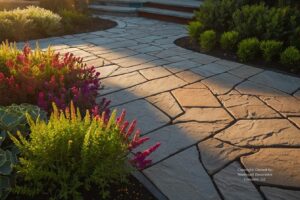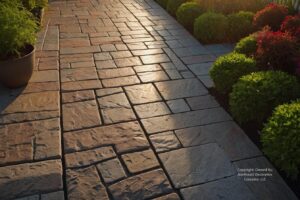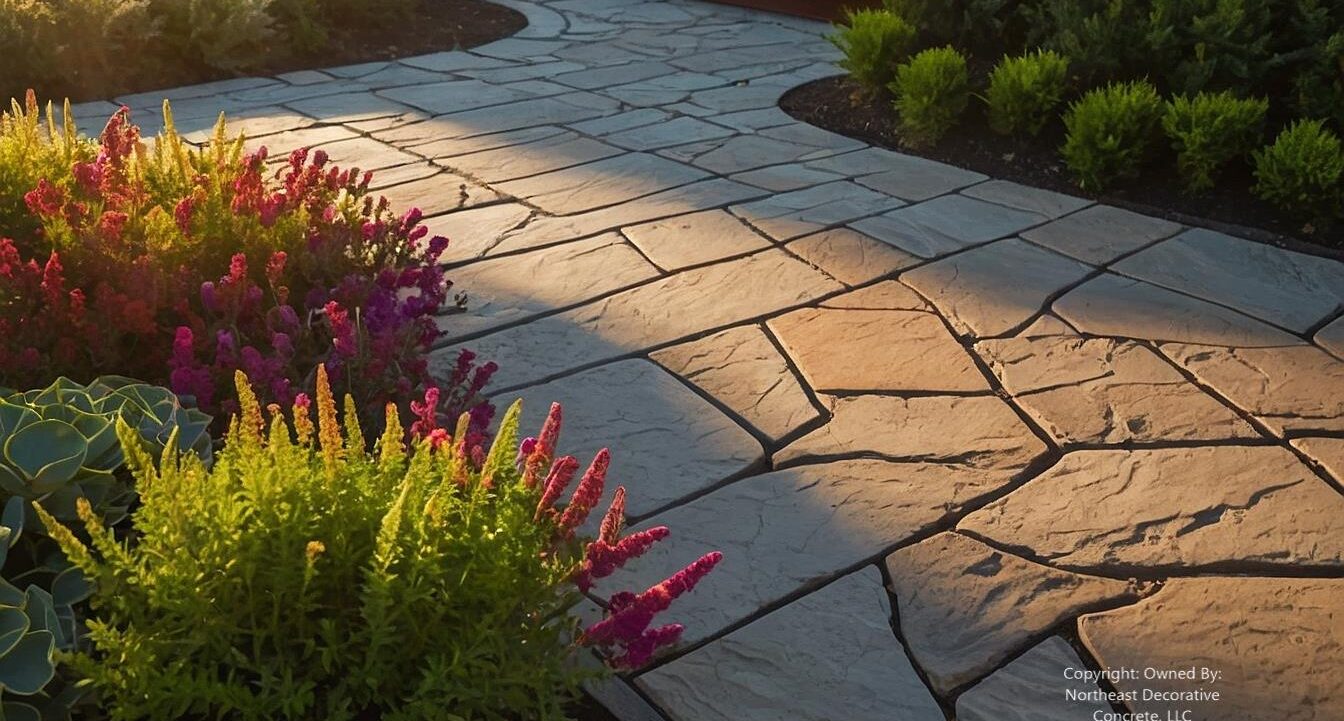
Landscaping Around Your Stamped Concrete Installation
Decorative concrete patios and walkways are a staple in New Hampshire homes. They’re durable, cost-effective, and mimic the look of natural stone or brick. But let’s face it—concrete alone can feel a bit cold. That’s where landscaping swoops in to save the day!
This guide will explain how to turn your stamped concrete into a lush, inviting oasis. We’ll cover plant choices, design hacks, and maintenance tricks tailored to NH’s climate. Plus, we’ll sprinkle in real-life examples and pro tips to keep things practical (and fun).
Key Takeaways
-
Match plants to NH’s climate and your concrete’s style.
-
Use edging and lighting to define spaces.
-
Plan for drainage to protect the concrete from frost and water damage.
-
Stick to low-maintenance native species for easier upkeep.
Landscaping around your NH decorative concrete doesn’t have to be complicated. You’ll transform a plain patio into an easy-to-maintain backyard paradise with the right plants and creativity. Now grab that shovel and get growing!

Landscaping Matters for Stamped Concrete Walkway
Stamped concrete isn’t just a slab—it’s the foundation of your outdoor living space. Pairing it with the right plants and features:
-
Softens hard edges
-
Adds color and texture.
-
Prevents soil erosion.
-
Boosts curb appeal (and property value)!
But NH’s weather throws curveballs: frost heaves, acidic soil, and heavy snowfall. Your landscaping needs to withstand it all.
Step 1: Plan Your New Hampshire Concrete Designs
Key Questions to Ask:
-
What’s the purpose of the space?
-
Entertaining? Kids’ play area? Quiet retreat?
-
-
How much sun/shade does the area get?
-
Full sun (>6 hrs), partial shade (3–6 hrs), or full shade?
-
-
What’s your soil type?
-
NH soil tends to be acidic (pH 4.5–6.5). Test it with a $10 kit from Walmart.
-
Landscaping around New England stamped concrete services providers will guide you to make wise choices about your needs.
Step 2: Pick Friendly Stamped Concrete Patios Plants
Not all plants play nice with stamped concrete designs. Avoid species with invasive roots (e.g., willow trees) or messy berries. Here’s what works:
Best Plants for NH Stamped Concrete Patio Landscaping
| Plant Type | Examples | Sun Needs | Maintenance | Pro Tip |
|---|---|---|---|---|
| Ground Covers | Creeping thyme, sedum | Full sun | Low | Perfect for filling gaps between pavers. |
| Ornamental Grasses | Blue fescue, switchgrass | Full sun | Low | Adds movement and texture. |
| Native Shrubs | Winterberry, inkberry | Partial shade | Moderate | Attracts birds and resists deer. |
| Perennials | Hostas, daylilies | Shade | Low | Hostas thrive in NH’s acidic soil. |
A homeowner in Bow, NH, lined their stamped concrete patio with sedum and blue fescue. The result? A low-maintenance, drought-resistant customization border that stays green from spring to fall.

Step 3: Stamped Concrete Contractor Ideas to Elevate
1. Edge It Up
Use stone brick pavers or metal edging to create clean lines between concrete and garden beds in an outdoor space. This prevents mulch from spilling onto your patio.
2. Go Vertical
-
Climbing plants: Boston ivy or clematis on trellises.
-
Raised planters: Build cedar boxes for herbs or flowers.
3. Add Lighting
-
Solar path lights ($20/pack at Home Depot) are along the concrete.
-
String lights overhead for evening ambiance.
4. Water Features
A small fountain or birdbath adds sound and movement. To avoid water damage, place it 3 feet from concrete.
Step 4: Tackle Specific Concrete Driveway Challenges
Problem: Frost Heaves
Solution: Plant deep-rooted shrubs (e.g., juniper) nearby to stabilize the soil.
Problem: Snow Melt Pooling
Solution: Slope garden beds away from concrete. Use gravel trenches for drainage.
Problem: Salt Damage
Solution: Avoid de-icing salts. Use sand or pick salt-tolerant plants like Russian sage.
Step 5: Seasonal Decorative Concrete Maintenance
| Season | Tasks |
|---|---|
| Spring | – Inspect for cracks – Refresh mulch – Prune shrubs |
| Summer | – Water plants deeply 2x/week – Weed weekly |
| Fall | – Rake leaves off concrete – Plant bulbs for spring |
| Winter | – Avoid shoveling ice (use plastic tools) – Cover sensitive plants with burlap |
Pro Tip: Reseal stamped concrete pool deck every 3–5 years with a solvent-based sealer to prevent stains and cracking.
Real-Life Makeover: A Plaistow NH Homeowner’s Story
The Challenge: A 20-year-old outdoor concrete project space with a stamped concrete patio looked dull. Runoff also eroded the durability of the soil.
The Fix:
-
A dry creek bed with river rocks was added to redirect the water.
-
Planted inkberry shrubs and hostas for year-round greenery.
-
Installed solar lights and a cedar pergola.
Result: The patio became the family’s favorite summer hangout—no more mud puddles and easy to maintain!
Frequently Asked Questions:
Q: How does NH’s acidic soil (pH 4.5–6.5) impact plant selection near stamped concrete driveway?
Answer:
NH’s acidic soil doesn’t suit alkaline-loving plants. Instead, it supports acid-tolerant species like hostas, hydrangeas, and rhododendrons. Pair these with stamped concrete by:
-
Amending soil pH with lime (for plants that need a neutral pH).
-
Root barriers (e.g., 24-mil HDPE) prevent acidic soil reactions with concrete sealants.
-
Avoid plants with high iron uptake (e.g., blueberries), which can stain unsealed concrete.
Q: What root barrier specifications prevent invasive species from damaging stamped concrete joints?
Answer:
-
Material: 24–40 mil thick HDPE or rubber root barriers.
-
Depth: 18–24″ profound, extending 6″ above grade to block surface roots.
-
Installation: Angle barriers 15° away from concrete to redirect growth.
Example: Winterberry shrubs, which are native to NH, need barriers. This stops their roots from growing into expansion joints.
Q: What slope gradient is required for landscaping beds to prevent frost heave under decorative concrete?
Answer:
-
Minimum slope: 2% (¼” per foot) away from concrete edges.
-
Drainage layer: Add 6 to 12 inches of ¾-inch crushed stone under the soil. This helps reduce hydrostatic pressure.
-
NH fix: Install a 4″ perforated PVC French drain for flatbeds and line it with geotextile fabric.
Q: Which geotextile fabric specs stop soil from moving into stamped concrete’s aggregate base?
Answer:
Material: Non-woven polypropylene (4–6 oz/sq yd) with 0.05–0.2 mm pore size.
Function: Lets water drain and keeps fine soil particles from entering the ¾” crushed stone base layer.
Placement: Install between subsoil and gravel base, extending 6″ beyond landscaped edges.
Q: How does irrigation system design affect decorative concrete longevity in NH’s acidic soil?
Answer:
-
Spacing: Drip lines must be ≥18″ from concrete edges to prevent pH-altering water saturation (NH soil pH 4.5–6.5).
-
Materials: Use Schedule 40 PVC pipes. Avoid galvanized steel risers. They can corrode and stain concrete.
-
Timing: Set irrigation for midday (10 AM–2 PM). This helps limit moisture exposure and lowers the risk of efflorescence.
Our Locations:
Nashua, NH
North Hampton, NH
Concord, NH

